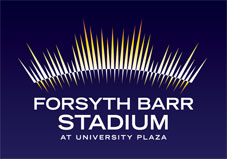Forsyth Barr Stadium
| 'Glass House' | |
 |
|

View of the stadium from the south-east
|
|
| Former names | New Carisbrook, Dunedin Stadium, Awatea Street Stadium, Otago Stadium |
|---|---|
| Location | Anzac Avenue, Logan Park, Dunedin, Otago, New Zealand |
| Coordinates | 45°52′9″S 170°31′28″E / 45.86917°S 170.52444°ECoordinates: 45°52′9″S 170°31′28″E / 45.86917°S 170.52444°E |
| Owner | Dunedin City Council |
| Operator | Dunedin Venues Management Ltd |
| Capacity | 30,748 (Rugby/Football) 36,000 (Concerts) 15,000 (Rodeo) |
| Surface | Desso GrassMaster |
| Construction | |
| Broke ground | May 2009 |
| Opened | 5 August 2011 |
| Construction cost | NZ$ 198.3 million |
| Architect |
Jasmax Populous |
| Tenants | |
|
Otago (2011–) Highlanders (2012–) Southern United FC (2011–) |
|
The Forsyth Barr Stadium is a multi-purpose stadium in Dunedin, New Zealand. At various stages of development it was also known as Dunedin Stadium or Awatea Street Stadium, or its non-commercial official name during the 2011 Rugby World Cup and 2015 FIFA U-20 World Cup, Otago Stadium. It is also known colloquially as 'the glasshouse' due to its resemblance to a horticultural hothouse. The stadium was opened by New Zealand Prime Minister John Key on 5 August 2011, replacing Carisbrook as the home stadium of the Highlanders team in Super Rugby and the Otago in the domestic ITM Cup. The stadium hosted four matches of the 2011 Rugby World Cup, and after hosting Elton John in November 2011 hosted more major music events in April 2013, when Aerosmith and Paul Simon performed in New Zealand for the first time.
The stadium is located in Dunedin North, close to the outflow of the Water of Leith into Otago Harbour (and directly over the outflow of Opoho Stream). Its site is close to several other major sports venues. Logan Park lies immediately to the north, and the University Oval and the Caledonian Ground are also nearby to the north of the stadium. Also to the north of the stadium is Logan Point quarry, at the foot of Signal Hill.
...
Wikipedia
